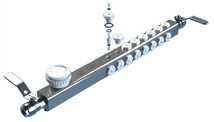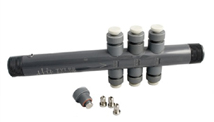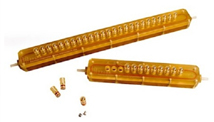TACT Engineering manufactures a range of standard devices (TACT Tools) for the growth and analysis of biofilms. Precision machined from stainless steel, polysulfone, homopolymer acetal, PVC, or acrylic, TACT Tools are classed as ultra-high pressure, high pressure, medium pressure and low pressure devices.
Microbiological Control & Fluid Dynamics
While biofilms can form on virtually any surface, the anchoring of planktonic bacteria to initiate biofilm formation on substrate walls is enhanced in regions experiencing significant shear forces. In pipelines, this correlates to regions of high velocity laminar flow (along smooth pipeline walls, for example) and to domains experiencing transitional or turbulent flow (valve interiors and pipeline flange connections, for example).
Laminar flow is defined as streamlined, in which fluids flow in parallel layers with no disruption between them. The velocity of fluids moving in pipelines is typically optimized for laminar flow according to the equations of fluid dynamics in which the Reynolds number (a measure of the ratio of inertial forces to viscous forces) is defined as:
![]()
Where:
 is the hydraulic diameter of the pipe (m)
is the hydraulic diameter of the pipe (m) is the volumetric flow rate (m3/s)
is the volumetric flow rate (m3/s) is the cross sectional area of the pipe (m2)
is the cross sectional area of the pipe (m2) is the mean relative particle velocity (m/s)
is the mean relative particle velocity (m/s) is the dynamic viscosity of the fluid (kg/m∙s)
is the dynamic viscosity of the fluid (kg/m∙s) is the kinematic velocity (ν=μ/ρ) (m2/s)
is the kinematic velocity (ν=μ/ρ) (m2/s) is the density of the fluid (kg/m3)
is the density of the fluid (kg/m3)
In general, a Reynolds number of less than 2000 will result in laminar flow in pipes of circular cross section, values between 2000 and 4000 will lead to transitional flow, and values above 4000 will result in turbulent flow. Fluid dynamics is therefore a critical consideration for any device attempting to simulate conditions found in the field. TACT Tools are designed specifically to mimic field conditions so that a direct correlation can be made between biofilm growth observed in the test system and that of the system being monitored.
Biofouling & Microbiologically Induced Corrosion (MIC) Monitoring
The workhorse for industrial biofilm management is our ultra-high pressure device, UHP-BD24-SS. This stainless steel TACT Tool is intended for extreme environments at pressures of up to 3000 psi (or to 5000 psi with a simple change out of ball valves and gauge), with 24 ports to permit the extraction and introduction of biostuds (coupons of specific composition and surface finish) at prescribed time intervals so that all stages of biofilm growth can be modeled and monitored. Biostuds are available in virtually any material and surface finish to match field conditions.
TACT Tools are designed to permit sampling in the field without disruption of plant or pipeline operations. In a process requiring less than a minute, exposed biostuds may be removed and transferred to cassettes for analysis at TACT Engineering or on site, with sterile biostuds replacing them so that time course sampling can be continued indefinitely.
TACT Tools are also available in high pressure and medium pressure versions for use in the field or laboratory. As well, a series of low pressure TACT Tools specifically for the lab are designed to accommodate the 50mm2 biostuds of the UHP-BD24-SS manifold. This permits the laboratory analysis of field-acquired biofilms without the need to re-culture and potentially destabilize colonies.



